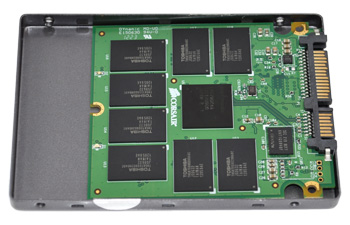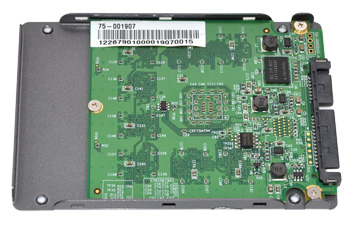Introduction
It's fair to say that Corsair has played it safe with its SSDs thus far. The manufacturer is rarely first to market, but the wait-and-see approach has its benefits; Corsair's SSDs are typically well-rounded, with few bugs and great performance.
And Corsair isn't afraid to have its fingers in multiple pies. The Performance Pro offers a lot of what's good about the popular Marvell controller, the Accelerator works well as a cheap-and-cheerful cache, and the Force Series 3 has delivered SandForce speed at a respectable price for well over a year. Speaking of flavours, Corsair also recently got around to pairing the much-vaunted SandForce controller with high-speed Toggle Mode NAND in the belated Force Series GS.
The company's SSD portfolio is about as versatile as they come, but Corsair appears to have grown tired of playing catch up and it's now attempting to get one over its many competitors with an SSD that's genuinely new.
It's dubbed the Neutron Series and, shock horror, it isn't powered by the usual suspects Marvell or SandForce. This time around, Corsair's teamed up with Link_A_Media Devices (LAMD) to introduce the world's first consumer SSDs armed with an LM87800 controller.
LAMD is a name that will be new to many, but the manufacturer isn't exactly a novice in the field. Founded in 2004 and based out of California, LAMD has eight years of experience in building storage controllers and a recent acquisition by memory giant SK Hynix suggests that it must be doing something right.
The ARM-powered LM87800 controller that has caught Corsair's eye certainly has potential, it's capable of speeds of up to 550MB/s over a SATA 6Gbps interface, while random 4K write performance is rated at up to 90,000 input/output operations per second. The numbers are in line with what we'd expect to see from a high-end SandForce drive, but Corsair's hoping that its exclusive use of the LAMD controller will allow the Neutron Series to stand out from the crowd.
As you'd expect, the LM87800 has built-in support for the performance-prolonging TRIM command and the S.M.A.R.T monitoring system, it can be paired with various flavours of NAND - including Synchronous and Toggle Mode - and it makes use of a proprietary eBoost technology that claims to "significantly enhance NAND Flash endurance." Interesting to note that LAMD isn't in the habit of revealing the inner workings of its chip architecture - it wants to keep certain secrets to itself - but we do know that the LM87800 doesn't use on-the-fly compression, so unlike SandForce drives, performance should remain strong when working with incompressible data.
The ability to pair the LAMD controller with different types of NAND gives Corsair enough flexibility to produce two unique Neutron Series models, and the LM87800 chip provides eight NAND channels that each support up to four NAND die - paving the way for drives of up to 1TB in capacity.
Corsair appears to be so confident in LAMD's potential that it's introducing not one, but two unique models of Neutron Series drive; the Neutron and the Neutron GTX. The former, pictured above in a 240GB guise, has the LM87800 controller paired with 16 synchronous NAND memory chips from Micron weighing in at 16GB apiece and a 256MB cache that's split across two DDR2 chips from Samsung - 128MB is placed on either side of the PCB.
The 240GB Neutron GTX, pictured below, spices things up by swapping out the synchronous NAND for high-performance Toggle Mode NAND from Toshiba. Eight 32GB chips are used, and the GTX drive comes equipped with the same 256MB DDR2 cache.
Save for the different label and the unique assortment of NAND, both drives are otherwise identical. The metal chassis clips together without screws and feels suitably rigid, and it's worth noting that Corsair has opted to deliver the Neutron drives in a 7mm-thick package. A 2.5-to-3.5in mounting bracket is included as part of the bundle, and Corsair has most bases covered; this is a drive that will fit in many ultra-thin laptops.
If the type of NAND is the only tangible difference between Neutron and Neutron GTX, how much faster can the latter really be? As it turns out, quite a bit. Toggle Mode NAND typically offers improved write performance, and that underlying promise is borne out in each drive's specification.
120GB Neutron Series |
240GB Neutron Series |
120GB Neutron Series GTX |
240GB Neutron Series GTX |
|
|---|---|---|---|---|
| Total drive capacity | 128GB |
256GB |
128GB |
256GB |
| Formatted capacity | 111GB |
111GB |
||
| Max. sequential read speed | 555 MB/s |
555 MB/s |
555 MB/s |
555 MB/s |
| Max. sequential write speed | 211 MB/s |
370 MB/s |
330 MB/s |
511 MB/s |
| Max. random 4k write | 85k IOPs |
85k IOPs |
80k IOPs |
85k IOPs |
| NAND type | Synchronous |
Synchronous |
Toggle Mode |
Toggle Mode |
| Max. power consumption | 4.6 W |
4.6 W |
4.6 W |
4.6 W |
| Warranty | 5 years |
5 years |
5 years |
5 years |
| Approx. price |
As depicted by the table above, both 240GB drives offer maximum read speeds of up to 555MB/s, but the premium NAND used by the Neutron GTX bumps sequential write performance up from 370MB/s to 511MB/s. A near-40 per cent increase is nothing to scoff at, but the write performance is linked directly to the number of internal NAND die - hence the slower speeds in the 120GB models - and the added potency of the GTX drives is reflected in a higher asking price.
And price, we feel, is going to be the Neutron Series' biggest hurdle. The fact that today's high-end SSDs are teetering on the edge of what's possible through a SATA 6Gbps interface make it almost impossible for a new SATA drive to come along and tear up existing benchmarks. That puts the Neutron Series in a bit of a predicament; it isn't going to break new ground in terms of sheer performance, and pricing on the top-pf-the-line GTX model isn't yet as keen as competing drives that have been available for some time.
Initial listings put the 240GB Neutron at around £158, while the premium 240GB Neutron GTX fetches £200. SSD prices have fallen so quickly in recent months that the GTX doesn't appear particularly tempting; today, a tried-and-trusted 256GB Crucial M4 is available at around the £150 mark, and even Corsair's fastest SandForce solution - the Force GS - costs less than the Neutron GTX, at £160 for a 240GB drive.
The Neutron drives face an uphill battle, but pricing should settle over time and the real question here is whether or not the LM87800 controller has what it takes to mix it up with some of the established names.















